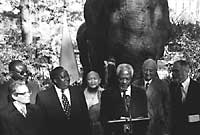|
|
||||
|
The life-size
elephant bronze was officially received |
||||
|
Ambassadors of Namibia, Nepal, Kenya, Lama Gangchen, Kofi Annan, Mihail, Hans Janitschek |
On the 18th of November 1998, a dream became a reality for many when the Secretary General of the United Nations officially accepted the gift of a life-sized elephant on behalf of the UN. Bulgarian sculptor Mihail, took nearly 20 years to «take the image off the wall and bring it back to nature» in a symbolic truce with nature. The bronze cast was presented to the UN by the Governments of Kenya, Namibia and Nepal as a symbol of all animals and to raise awareness about threatened wildlife. This elephant bronze is the final sculpture to be installed in the Sculpture Garden of the UN headquarters in New York. Organised by «Cast the Sleeping Elephant Trust» and co-sponsored by the Lama Gangchen World Peace Foundation, the event drew both crowds and journalists who gathered to see its unveiling The Secretary General in his memorable speech said: «Elephants, whether asleep or awake, evoke many things to many people. A former Governor of Brazil’s Central Bank said his country’s domestic debt was like having an elephant sleeping in the basement of your house, and wondering when it would wake up and ask for peanuts. Mihail Simeonov went to Kenya 18 years ago, tranquilized a wild bull elephant and took a cast of it before releasing it unharmed in to the wild. Since that day, the story has taken many twists and turns. The last wrangle concerned the mode of transport from the foundry in Queens; finally it was wheeled on the back of a flat-bed truck along First Avenue, and a crane was on hand to put it in place. But as we see this animal stand before us today, it was worth the wait. The sheer size of this magnificent creature humbles us. And so it should. For it shows us that some things are bigger than we are. It tells us that the Earth is not ours, but a treasure we hold in trust for future generations. It teaches us that if our global village is to be a truly desirable place for all of us on this planet, it must be guided by a wish to nurture and preserve, and not to threaten or destroy, the variety of life that gives it value. And so, as the animal that never forgets, let the elephant serve as our institutional memory; let us remember that when future generations come to this garden as mature adults, this elephant will still be here. As we walk by it in the days and years to come, may all five tons of it stand as a daily reminder that we are all in debt to Mother Earth; that we ignore this at our peril; and that if and when the elephant wakes up because we have failed in our duty, chances are it will ask for much more than peanuts!» Isthar D.-Adler |
|||
|
|
||||


